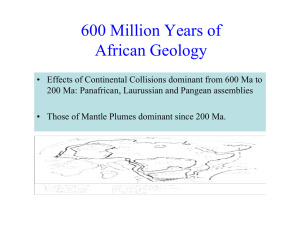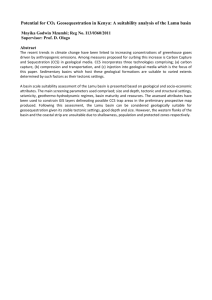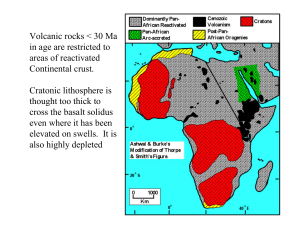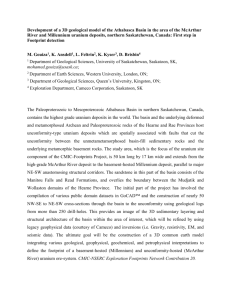Document 13507379
advertisement
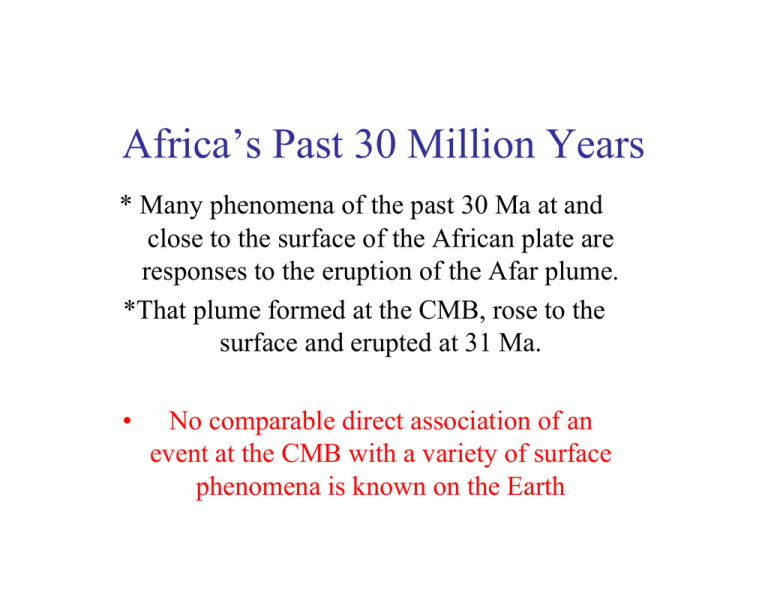
Africa’s Past 30 Million Years * Many phenomena of the past 30 Ma at and close to the surface of the African plate are responses to the eruption of the Afar plume. *That plume formed at the CMB, rose to the surface and erupted at 31 Ma. • No comparable direct association of an event at the CMB with a variety of surface phenomena is known on the Earth Before Northern glaciations began (2.8 Ma) conditions from 34 Ma (when East Antarctic ice sheet formed) were similar to those of interglacials of the past 2.8 Ma (Figs.C &D) A B GLACIAL JANUARY H T JULY H L T G N S N.E. MONSOON G DRY N.E. TRADES C N C DRY N.E. TRADES GLACIAL H (ALOFT) S I.T.C. WET WESTERLIES Sahara first formed at 2.8 Ma. I.T.C. Z WET WESTERLIES Z EASTERLIES S. WESTERLIES S.E. TRADES DRY WESTERLIES K S. ATLANTIC ANTICYCLONE DRY WESTERLIES H K S. ATLANTIC ANTICYCLONE L S.E. TRADES H WEST WIND DRIFT S.E. TRADES H H WEST WIND DRIFT COLD FRONTS INTERGLACIAL I.T.C. C H JANUARY T INTERGLACIAL T C MONSOON C N S D JULY G N July ITCZ reached far to the north before 2.8Ma COLD FRONTS N.E. TRADES I.T.C. H PLUVIAL N.E. MONSOON G S S.W. MONSOON Z S.E. TRADES Z MONSOON L S.E. TRADES S.E. TRADES K K BENGUELA CURRENT BENGUELA CURRENT S. ATLANTIC ANTICYCLONE AGULHAS CURRENT H H COLD FRONTS COLD FRONTS High pressure L Low pressure Winds H WEST WIND DRIFT WEST WIND DRIFT H S.E. TRADES AGULHAS CURRENT H H S.E. TRADES DRY WESTERLIES S. ATLANTIC ANTICYCLONE Ocean currents Cyclonic rains Cold fronts Upwelling water Monsoon I.T.C. Inter-Tropical Convergence Congo Basin (Z) is always wet. Pluvial conditions K Kalahari Basin T Taoudeni Basin C Chad Basin N Niger Basin Z Zaire Basin G Gezira Basin S Sudd Basin Namib has been a desert since 34 Ma because of Benguela current Burke et al 2002 AFRICAN PLATE PINNED HOW ? As a result of Afar plume eruption. WHEN ? 30 million years ago. WHAT HAVE THE CONSEQUENCES BEEN ? Shallow mantle convection as a result of which: (1) Basins, Swells and Rifts are forming. (2)Intraplate volcanic activity on swells. (3) Erosion of high ground. (4) Deposition, mainly offshore. Paleomag shows plate twice at rest in past 200 Ma 45o Rotation intervened between 130 and 30 Ma Image courtesy of The Geological Society of South Africa. Intermittent igneous activity in small areas (~ 300 km diameter) shows that the African plate has not moved with respect to the underlying mantle convection pattern for ca.30 My. Four of many areas selected. Image courtesy of The Geological Society of South Africa. Alice Gripp and Richard Gordon found that Africa had moved little in the global hot-spot reference frame for the past 3.7 My. Their interest was in the Pacific. I cut their map in half, pasted and scanned it. Image courtesy of The Geological Society of South Africa. ACTIVE AFRICAN BASINS AND SWELLS ARE UNIQUE THEY HAVE ALL FORMED IN THE PAST 30 My IN ORIGIN THEY ARE UNLIKE FAMILIAR TYPES OF BASIN AND FAMILIAR TYPES OF MOUNTAIN BELT World Map of Topography and bathymetry Unique character of African Plate Basin & Swell structure Image courtesy of NOAA and USGS. Basin and swell structure of the African continent has long been recognized. This map is based on Holmes’ 1944 map. Krenkel (1923) spotted that volcanoes are on swell crests. He suggested that mantle melting a process that he called ”MAGMARSIS”made the swells. BASINS AND SWELLS Image courtesy of The Geological Society of South Africa. Argand attributed the basin and swell structure to long wavelength compressional folding. He called those folds “plis de fonds”(“basement folds”) Image courtesy of The Geological Society of South Africa. AFRICA WAS A RELATIVELY QUIET PLACE BETWEEN 130 Ma AND 30 Ma (That has to be demonstrated to show that something really did happen at 30 Ma) The Afro-Arabian plate, surrounded by spreading centers, grew larger from 130-30 Ma. The continent was low-lying with little igneous activity. A few large rivers, many of which flowed in existing rifts drained the continent. Relatively little siliciclastic deposition off-shore except in the deltas of major rivers. Sirt fed by long rivers into a broad estuary Africa low-lying Before 30 Ma Cret.desert Arabia mainly carbonates and sabkha A Atlas low lying near sea level north of this line, shoreline fluctuated rapidly 150-30 Ma sho Bulge from A to B a) ocean floor from 180 Ma b) carbonate shelf 180-125 Ma c) deltas 135-65 Ma ulde rs Europe Tan Tan Abu Gharadig thin non-marine “Nubian” and ”Hamadian” sandstones Casamance B I M Cretaceous Equator high rainfall laterites and bauxites formed between desert latitudes, silcretes and calcretes further south forest 10 m dinosaur-catching crocodiles Interior marine transgressions a) I (Iullemmeden Basin, Gao rift) five between 100 and 50 Ma b) M (Benue and Maidugari Basins) five between 100 and 50 Ma c) NEC (North East Congo) only late Cretaceous. MM (Mahura Muthla) land plants in river gravels erosion from rift shoulders deltas in Benue rift before 85 Ma, onto ocean floor from 80 Ma Anza NEC 80 Ma pulse Amazon until 125 Ma Lamu Delta 150-34 Ma Ogooué short rivers deltas on carbonate shelf Kalahari or Orange Delta mainly 122-95 Ma, 80 Ma pulse, little since 70 Ma) Karroo like Orange, but more deposition in Cenozoic desert over much of the Congo Basin ? delta Rufiji ? early thin Kalahari sands MM marine transgression up rift? Zambezi Delta • major delta 150-65 Ma • no 65-30 Ma delta Zambezi Limpopo R. Caledon Tugela, 1st pulse ca. 140 Ma (no 65-30 Ma delta) Agulhas, deposition mainly in rifts deltas African rifts, and deltas 150 Ma to 30 Ma. Ma Riftrivers shoulders wereca. eroded by()ca.90 (early Oligocene). 84 M tectonics not emphasized. 140 to 30 Ma AFRICA A LOW­ LYING CONTINENT FLAT AND SUBJECT TO MARINE INCURSIONS AT HIGH­ STANDS Iullemeden basin is 1000 km inside the continent Limited African plate igneous activity from ca.130-30 Ma Cameroon line granites 65-30 Ma, S.Ethiopian rift 45-35 Ma Tristan plume active,Deccan plume active (dies at 31Ma) Namaqualand 60-45 Ma (On a crack?) Agulhas 40 Ma Canary Island and Jebel Uweinat now known < 30 Ma Image courtesy of The Geological Society of South Africa. IGNEOUS ACTIVITY THAT STARTED AT ~30 Ma: Small volumes, mostly on swells, onshore and offshore. Afar plume products,which are of deep-seated origin, provide the exception Decompression melting igneous activity In the East African Rift system is distinct being part of the rift system evolution. CHARACTERISTIC FEATURES OF VOLCANO-CAPPED SWELLS OF THE AFRICAN PLATE (1) (2) (3) (4) (5) Elliptical, longer axes 100-2000 km. On continent or ocean floor. Amplitudes low on ocean floor. Related to < 30 Ma basement uplift. Basaltic rocks dominant. 3He/4 He less than or similar to MORB. Afar, Reunion are exceptions. (6) Volcanic rocks mainly derived from HIMU source. Afar and Tristan are exceptions. They show EM1 and EM 2. (7) Volcanic volumes small compared to LIPS. Afar exception. (8) Episodic eruption in same small areas (d<~ 300 km) back to as old as ~ 30 Ma in some cases. (9) Volcanoes on swells show no consistent azimuthal age progression. There is progression on some swells but azimuths vary and tracks (for the past 30 My) < 300 km. ( From: Burke J.Geology 2001) Isotope geochemistry in the Hart& Zindler Style. FOZO is between DMM and HIMU Image courtesy of The Geological Society of South Africa. Basin & Swells Offshore: Limited erosion, thermal subsidence, deep-water deposits since 30 Ma Elevations persist. Hard to date Offshore swells. Amplitudes are mostly small 125 Ma submarine scarps. (Burke, 1969) Onshore: Ethiopia: At sea level before 34 Ma (Sengor 2001) Volcanism started: 31 Ma. It continues. Swells have been rising ever since. No volcanoes on cratonic swells East Africa: Anza river delta killed ca. 30 Ma.as E.A. swell began to rise. Turkana rifts fed from south from 30 Ma (Smith 1992). West Africa: Dakar swell rise dated by volcanism since 24 Ma. No present relief: erosion by Senegal river. Image courtesy of NOAA and USGS. The AFAR plume is distinctively different----So lets get it out of the way It is different because it (or at least its energizing buoyant driving plume, if not its rock content), came from The Core/ Mantle Boundary AFAR PLUME LARGE IGNEOUS PROVINCE *”Ethiopian Traps”ca. 1 M km2 outcrop, ca. 1 km thick ( 1 M km3) *Bulk erupted between 31Ma and 28 Ma ( Hofman et al.) eruption persists from plume tail. Cited “increase” in past 5 My is partly because older rocks are buried and partly because sea floor spreading is beginning to penetrate the Afar. *Eruption has been in the same place although area of eruption has shrunk since 28 Ma. Plume site is now linked to regions of decompression melting in Ethiopian rift, Red Sea and Gulf of Aden. *Geochemistry: Schilling’s review still helpful. Menzies for Yemen 3 He up to 20x R . EM1 & EM2 reflect lithospheric source. HIMU ? A *Time of formation of intra-continental rifts in Red Sea, Gulf of Aden and East African rift is, within resolution, the same as the time of Afar LIP eruption. Isotopic ages(mainly K/Ar) of igneous rocks of Africa (Burke 1976). Gradual increase is probably unreal. A step in abundance at ca.30 Ma seems more plausible. Huge increase in < 5 My ages is relatable to hominid research. Image courtesy of The Geological Society of South Africa. Volcanic Activity In the Eastern Atlantic Started Ca.30 Ma (Soviet cruise Results) Image courtesy of The Geological Society of South Africa.

